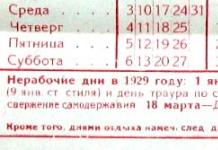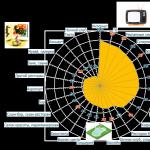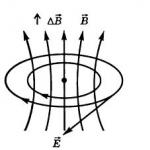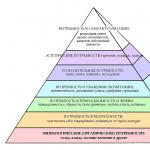Cellular concrete is generated by the following circumstances: firstly, for low-rise buildings the strength, density and labor intensity of brick and especially reinforced concrete are definitely excessive, and the heat and soundproofing properties are also definitely insufficient. Secondly, any known methods wood treatments guarantee durability and fire resistance wooden building more than 30 years only in particularly favorable operating conditions. Therefore, attempts to bring the properties of concrete closer to wood by creating voids or inhomogeneities in it were made back in the first half of the 19th century, and currently there are more than 10 types of cellular concrete. Foamed concrete is the most popular and promising, but the situation with them is not at all simple .
In Internet sources on the question: which is better, foam concrete or aerated concrete, there is unimaginable confusion, and in some cases clearly malicious. Construction sites of some neighboring countries are especially guilty of this. It is difficult to understand what is the egg and what is the chicken, but the typical situation is this: there is, for example, a website on which it is given quite objectively comparative analysis both materials. But! The properties of foam concrete are attributed to aerated concrete, and vice versa. That is, if “foam” and “gas” are swapped, everything will correspond to reality.
Next to the text, contextual advertising and links to suppliers are annoyingly visible. Go through them - they name their products correctly. Suddenly, an ignorant buyer, guided by what he has read, orders and pays, and a completely different material is delivered to him at the site. And, as they say, there are no limits: suppliers and publishers are not responsible for each other, and you can also push advertisers. Therefore, it is imperative to understand which of these two types of cellular concrete is better for construction.
Note: of other types of cellular concrete, we will further touch a little on expanded polystyrene concrete; It’s not that they lie about him, but they keep silent about something important. And with expanded clay concrete, wood concrete, fiber-reinforced concrete, etc., there seem to be no serious misunderstandings.
Why the confusion?
Sources that have the force of law, are authoritative, or at least claim to be objective, from SNiPs and polytechnic dictionaries (construction, explanatory, encyclopedic), to Wikipedia, provide a clearly visible criterion for the difference between foam concrete and aerated concrete. In the first, the pores are through, tortuous, irregular shape; in the second - rounded closed ones, see fig. But within each structure, differences in the properties and quality of the material are possible greater than between different structures. Simply: good foam concrete may be better than suitable aerated concrete. And another important point: the initial characteristics of both of these materials change differently and manifest themselves during operation, see below.

We'll see why this is so. For now, it is simply necessary to clarify the discrepancies of what scale we are talking about. Otherwise, it is impossible to objectively assess the pros and cons of foam and aerated concrete: behind the dry numbers in the tables lies a lot, which is what this article is actually about.
For example: you may have heard about the real estate situation in Spain. There, under the state program to save hapless developers from bankruptcy, about 800 thousand new (!) individual residential buildings were put up for auction. The prices are amazing. Here, for example, is the wonderful resort area of Costa Calida. Granada with its Alhambra and the ski delights of the Sierra Nevada is just a stone's throw away. And - a villa of 100 square meters of residential space is for sale on the 2nd beach line (3-10 min walk to the sea). The architecture is Novo-Andalusian, there is a swimming pool. The price of this paradise is 200,000 euros, 2000 euros per square. By local standards, this is not at cost, but at what they will charge.
Why? Let's look at the specification: construction material- a gas block of a European standard. What kind of Euro is this? We search, with difficulty, but we find. Oh, I see! Eurotakoito is a surrogate aerated concrete (see below for more details). Let’s compare the dates: there are 12 euros left in this building until the end of its design life of 20 years. Who will give even a Russian nickel for a house that is guaranteed to fall into disrepair in less than 15 years? Perhaps they would rent it for a porn studio or a brothel, but for a million establishments of this type, this is too much for Spain.
Here's an example of a different kind. In the 2000s and 1900s, a thorough revision of the foam concrete buildings of the USSR from the 30s to the 50s was carried out. It turned out that 95% of the buildings doubled or tripled their strength (!); their other characteristics have not deteriorated. These buildings have been declared fit for use after cosmetic repairs; Based on the current state, a second revision is scheduled in 80 years. 5% was dilapidated due to violations of construction rules. Considering that under Stalin, forced unskilled labor was widely used in construction labor force(prisoners), it must be admitted that the foam concrete of that time could withstand gross violations construction technologies, except those that are completely unacceptable.
We are looking again why this is so. The answer is simpler: the bulk of the material is Portland cement with quartz sand; foaming agent – natural protein (more about this below). This is the costa calida that comes out.
Stamps
Foam and aerated concrete is produced/manufactured in the following grades; The numbers indicate the mass density of the ready-to-use material:
- Thermal insulation, not capable of bearing a load - D200-D400 for foam concrete and D200-D300 for aerated concrete;
- Thermal insulation and structural materials, from which partitions and enclosing structures can be installed - D400-D800;
- Structural, for the construction of load-bearing building structures – D900-D1200.
Note: From here it can be seen that the first 2 groups of brands and partly the 3rd are lighter than water.
Production
To understand the clearly incongruous situation described above, you must first understand how the production of foam concrete differs from aerated concrete. Key Points Here:
- A method of creating voids in a material; simply - foaming.
- For aerated concrete – the conditions for holding the batch until it hardens.
- Composition and properties of the main (bearing) material.
- Method for forming building modules.
Foaming
It is the method of formation of voids that is the main difference between foam concrete and aerated concrete. Foam concrete is produced by adding organic foaming agents to mixing water. They come, firstly, from animal protein: the first samples of foam concrete were obtained by adding cement-sand mortar bull's blood. Secondly, it is based on saponins - substances that foam more than soap, but with a neutral chemical reaction. Saponins were first obtained from plants of the sapotaceae family (soap root, etc.), but now they are almost completely replaced by synthetics, which are much cheaper than natural extracts.
Protein blowing agents provide practically unlimited durability of a building - remember ancient buildings for which eggs were added to the masonry mortar. But given the current situation with animal protein in the world, protein foaming agents are very expensive and there is almost no protein-based foam concrete on sale. Saponins guarantee the relative stability of masonry characteristics for 40-70 years, and then its strength, moisture resistance and vapor permeability also drop steadily and quite quickly. The introduction of these and other foaming agents into the solution is possible directly on site, i.e. foam concrete can be monolithic. Saponin foam has a low or medium expansion, so the spread of the initial parameters of foam concrete is quite large.
Aerated concrete is mixed using a strongly alkaline solution (usually quicklime is used) with the addition of aluminum powder. In this case, hydrogen is released, which, together with the main mass, creates a high-expansion foam, due to which the original characteristics of the material are maintained with high accuracy. The technological process is organized in such a way that the volumetric concentration of hydrogen in the air never exceeds the explosive value of 4%. Due to the high diffusivity of hydrogen, it almost completely evaporates before the mass hardens, and its subsequently expiring residues are harmless and safe. But powdered aluminum and caustic alkalis are carcinogens and, lastly, toxins of high danger groups. The safety of production processes with them can only be ensured by incorporating it constructively into technological equipment; PPE can only be an addition.
Excerpt
Comparison of different brands aerated concrete must also be produced taking into account the method of holding the batch until technological hardening. The maturation of the foamed mass of aerated concrete is carried out either with heating without excessive external pressure (non-autoclaved aerated concrete) or in an autoclave under pressure (autoclaved aerated concrete). In terms of initial characteristics, they may not differ much, but more expensive autoclaved aerated concrete gives buildings made from it a service life of over 70 years, and non-autoclaved aerated concrete – up to 40-50 years. Frost resistance (the number of cycles of complete freezing/thawing before cracking begins) of autoclaved aerated concrete ranges from 80-100; non-autoclave – up to 30.
Bulk
The main thing you should pay attention to if you intend to is the composition of its bulk. The best results based on the results of operation are shown by mixtures of Portland cement and quartz sand; further, unless otherwise stated, we will consider cement-sand foamed concrete. However, a huge amount of foam and aerated concrete with a binder of slaked lime and a filler of thermal power plant ash, ground industrial slag, etc. goes on sale. industrial waste, this is the so-called. surrogate concretes. Their durability and frost resistance are 1.5-2 times less than that of cement-sand foamed concrete of the same brand, but other initial qualities may be no worse.
Surrogate foamed concrete can be white, dazzlingly sparkling, like refined sugar, even in coffee. But a foamed mixture of Portland cement with quartz sand can also be white, like writing paper. Here the selection criterion is the specification of the material or simply the markings on the packaging. Manufacturers of cement-sand foam and aerated concrete do not miss an opportunity to point out the merits of their products, especially in the conditions of fierce competition, and suppliers of surrogates prudently remain silent about the origin of their goods.
Blocks and monoliths
Individual developers use foam blocks or gas blocks for work. Aerated concrete is made only in production conditions and is produced in standard modules. To mix foam concrete on site, expensive purchased equipment is required, but still the spread of material characteristics is greater than acceptable. Therefore, only low grades of monolithic foam concrete are made on site; mainly for insulation and, rarely, enclosing structures. Videos give an idea of the methods for producing foam and gas blocks:
Video: production of foam concrete blocks
Video: production of aerated concrete blocks
Note: introductory video materials. Depending on the used production equipment These and other technological processes may differ significantly.
The dimensions of foam and gas blocks are maintained in a 300 mm module; standard – 300x300x600 mm. Low grade aerated concrete for thermal insulation is also produced in slabs in 150 and 125 mm modules, for example. 1200x600x150 mm or 1250x500x125 mm.
Aerated concrete and foam concrete can be machined with ordinary steel tools, but the former crumbles weakly and only from impact loads, and the latter crumbles strongly and, in addition to shocks, from uneven loads. Therefore, foam blocks are formed exclusively by pouring into molds. Saponin foam creates significant pressure, the molds burst, so the accuracy of manufacturing foam blocks is low: about 1% of the corresponding figure. size. That is, the transverse dimensions of a standard structural foam block can vary by 3 mm, and the length – by as much as 6.
Gas blocks are supplied for sale cast and cut. High-expansion hydrogen foam puts almost no pressure on the mold: the diffusion rate of hydrogen increases very quickly with increasing partial pressure, and excess gas simply evaporates. The dimensions of cast gas blocks can be maintained with an accuracy of +/–1 mm. Cut aerated blocks can generally have an accuracy of +/–0.5 mm that is fantastic for building materials, but they cost 5-15% more than cast ones, because Wear of cutting tools and waste of material cost money.
Jumpers, locks and weights
Due to the better ability of gas blocks to bear shock and uneven loads, together with higher manufacturing accuracy, it is possible, firstly, to lay the lintels of window and door openings in gas block walls from 150 mm (item 1 in the figure), while for foam blocks it is necessary to lay those the same structural elements from 300 mm. Secondly, gas blocks are also produced with shaped locks, pos. 2, providing greater strength and lower heat loss of the building.

Then, only sheathing sheathing can be attached to foam concrete walls with steel fasteners, with dowels installed for hardware from 150 mm; under concentrated loads you need to install through anchors. And a hook in a dowel with a depth of 120 mm in an aerated concrete wall holds a weight of up to 15-25 kg, depending on the type of material. That is, in order to hang, say, a TV on a foam concrete wall, you will need to damage the finish in the adjacent room. There are no problems with aerated concrete, on the contrary: you don’t need a hammer drill or a drill for concrete, it’s enough hand drill without a vibrator and a conventional twist drill. Accordingly, there will be less garbage.
Characteristics of foam concrete and aerated concrete
The most important performance characteristics structural cellular concrete, red brick and construction wood are summarized in table. The required wall thickness may cause some confusion, but it is calculated, firstly, for a bare wall, without internal and exterior finishing, sheathing and insulation for -25 outside. Secondly, it is taken into account that the homeowner does not pay for excess energy consumption at an increased tariff. And, to summarize, let’s go through some of its other significant lines.

Cost and shrinkage
Current prices for 1 sq. m the walls change, but their ratio remains approximately the same. However, a question may arise: how is it that foam concrete is almost a quarter cheaper than aerated concrete, and a wall made from it is more expensive? In addition to the thickness of the wall, the masonry joint also plays a role here. Gas blocks are placed only with special glue. High-quality adhesive for aerated concrete costs 2-3 times more than usual masonry mortar, but the latter needs 3-5 times more volume (see seam thickness).
Foam blocks can seem to be laid on glue, but foam concrete greedily absorbs moisture, see below, and the fresh seam dries out before the next block is laid. In addition, the accuracy of manufacturing foam blocks is almost equal to the thickness of the adhesive seam, which is unacceptable for reasons of strength.
Note: no need to pretend estimated cost construction for the price of a square wall. The total cost of construction depends on many factors, and, depending on local conditions, it may be comparable in price or even cheaper than stone.
Further, small dry (intrinsic) shrinkage of aerated concrete occurs quickly, within a month, and finishing can begin. Foam concrete settles within a year, and maintenance breaks also cost money. For an individual developer – at least for the rental of temporary housing. Finally, due to the crumbling of foam concrete under uneven load, the bearing capacity of the foundation of a foam concrete house should be higher, and its shrinkage less than for aerated concrete, i.e. and a foundation for foam concrete will cost more.
Humidity
Operating humidity means how much water vapor by weight a material can “pump” from the air. 5% or 15%, there is not much difference; eg For air-dried industrial wood, the moisture content is standardized at 20%. But the rate of moisture absorption is a completely different matter. It depends on the physical mechanism of moisture absorption: capillary or diffusion. The first is typical for foam concrete and wood, the second is for autoclaved aerated concrete, and non-autoclaved aerated concrete absorbs moisture in both ways. In turn, the rate of capillary moisture absorption very much depends on the cross-sectional size of the pores in the material.
Let's do the following. experience: take pieces of foam, autoclaved and non-autoclaved aerated concrete and wood same size, shape and density, i.e. weight. Let them float in a container of water. Before your very eyes, foam concrete will become saturated with water and sink. Let's continue the experiment, adding water as it evaporates. Non-autoclaved aerated concrete will float for 2 weeks - 3 months, but autoclaved aerated concrete will remain afloat even when the piece of wood has already sunk to the bottom. Let us remember: aerated concrete dampens slowly and is unimportant.
Vapor permeability
Here we compare foamed concrete with wood. Considering that wooden structures It doesn’t happen without ends in the air, it turns out that foam and aerated concrete “breathe” almost like wood. And if we remember how slowly autoclaved aerated concrete absorbs moisture, we come to the conclusion that it is almost better for a bathhouse than traditional wood. Moreover, its thermal conductivity is lower: the bath will warm up faster.
What is not in the table
Let’s complete our overview of the properties of aerated concrete with some additional parameters:
- Cold resistance – F35, i.e. mechanical characteristics persist down to –35 Celsius.
- Fire resistance – class A1, can withstand heating up to 300 degrees for 20 minutes without loss of strength.
- Permissible axial load of structural grades – class B2.5; It is permissible to erect walls up to 20 m high.
- Absolutely unattractive, unlike expanded polystyrene concrete (see below) for rodents and insects.
About expanded polystyrene concrete

Expanded polystyrene concrete, or foam concrete, is not one of the foamed concretes, but you need to stick with it. Foam concrete has been heavily advertised lately, and there seems to be a formal basis for this: it is cheaper than aerated concrete and is not inferior to it in most respects. But what foam concrete enthusiasts don’t talk about: its fire resistance zero, heating is not allowed. In a flame, polystyrene foam concrete collapses catastrophically, shatters into pieces with a crash, and, like foam plastic, emits a large volume of extremely toxic gases.
Bottom line (and what not to do)
What you don’t need to do is mix foam concrete yourself. Fiddling with aerated concrete components at home is simply dangerous to health, see above. As for foam concrete, there are plenty of “do-it-yourself” stories about it on YouTube. But they will show you either the work of a purchased installation that is expensive and requires qualified maintenance, or kneading in something like a basin or bucket. Is it possible to get cubes and tens of cubes this way? quality material for construction - a rhetorical question. Mix a component for floor insulation from retail purchased? “Spotty” insulation in terms of thermal conductivity is worse than poor, homogeneous insulation, because causes midge and mold. And the price will be comparable to ecowool insulation, which has a lot of its own advantages, but lacks the disadvantages of foam concrete.
Several terms are common for building materials made of cellular concrete - aerated concrete, foam concrete, in addition there are characteristics such as autoclave and non-autoclave. Let's look at the definitions.
Cellular concrete is the general name for all lightweight concrete, which is characterized by the presence of many pores (cells) in its structure, which impart improved physical and mechanical properties to the material.
According to the method of pore formation, cellular concretes are divided into:
- Aerated concrete
- Foam concrete
According to hardening conditions, cellular concrete is divided into:
- autoclave - harden in a medium saturated steam at pressure above atmospheric;
- non-autoclaved - hardens in natural conditions
Aerated concrete and foam concrete differ fundamentally in a number of parameters, ranging from composition to physical, technical and operational characteristics.
Production of foam concrete and aerated concrete: differences
Foam concrete is a mixture concrete mixture and special foaming additives, which is created by mixing. The foaming agent for foam concrete can be synthetic or organic origin. When producing foam concrete, the mixture is poured into individual molds, in which, after hardening, ready-made foam blocks are obtained. Foam concrete hardens and gains strength in natural atmospheric conditions, which does not allow it to achieve the declared strength characteristics. Excess humidity also has a negative effect.
Autoclaved aerated concrete, unlike foam concrete, is produced in a factory and it consists entirely of mineral raw materials. The components for the production of aerated concrete are sand, lime, cement, gypsum, water and aluminum paste as a gas former. Pores in aerated concrete are formed by a reaction that results in the release of hydrogen, which forms pores.
Precise dosing and mixing of all components is ensured by a fully automated installation. The contents are then poured into special forms, where the mixture swells in a chemical reaction. Ultimately, a mass with a large number of pores and cells is formed. Therefore, the product was called “aerated concrete”. After the array is lifted, some more time passes, after which it is sent for cutting.
The cutting of the massif is carried out using thin strings. WEHRHAHN cutting technology, which has been refined over decades, now provides cutting precision that significantly exceeds tolerance limits. This ensures the ideal geometry of the blocks and, therefore, the minimum thickness of the seams when laying aerated concrete blocks, which subsequently practically prevents the appearance of cold bridges, as well as a significant reduction in the cost of plastering smooth walls.
Aerated concrete hardens in autoclaves in an atmosphere of saturated steam at a temperature of about 180-190°C and a pressure of 12 atm. In this case, a unique crystalline structure is formed, which gives autoclaved aerated concrete its excellent properties because high strength, thermal resistance, durability, resistance to temperature differences, minimal release humidity, high coefficient of vapor permeability, which distinguish it from non-autoclaved building materials.
Finished blocks and slabs are packed in shrink film and then sent to the Customer.
Quality stability
Autoclaved aerated concrete manufactured at large production. Full automation and computerization production process provide guaranteed high quality products. Quality control of raw materials, semi-finished products and technological processes, including input, operational and acceptance, is carried out at all technological stages production. This is largely possible thanks to highly qualified personnel and a modern laboratory equipped with high-tech equipment that allows not only to control input raw materials, but also to produce prototypes finished products.
Manufacturing foam concrete blocks does not imply quality control of raw materials, does not have a laboratory to control the quality of finished products, in addition, violations of technology are possible. In essence, this is handicraft production with unstable quality indicators.
Strength
Foam concrete or aerated concrete manufactured in various densities. Foam concrete is significantly inferior to autoclaved aerated concrete in terms of physical and mechanical properties and strength. Moreover, given the method of producing foam concrete and the desire of manufacturers to reduce the cost of foam blocks, instead of expensive foaming agents and materials, their more expensive ones are often used. cheap analogues. As a result, the strength indicators of foam concrete are unstable and can vary significantly depending on the different points block, while autoclaved aerated concrete is an absolutely homogeneous material with stable strength indicators throughout the entire mass.
Drying shrinkage
IN foam concrete masonry higher risk of cracks. This is due to the fact that the drying shrinkage rate, which is an important performance indicator, is significantly less than for foam concrete blocks and does not exceed 0.3 mm/m (for foam blocks this figure ranges from 1 to 3 mm/m).
Environmental friendliness
Autoclaved aerated concrete is an absolutely environmentally friendly and vapor-permeable material. Therefore, in a house made of autoclaved aerated concrete there is always a favorable microclimate for living, similar to the climate wooden house. Aerated concrete is made from mineral raw materials, therefore it is not at all susceptible to rotting, and due to the ability to regulate air humidity in the room, the likelihood of fungi and mold appearing on it is completely eliminated.
Foam concrete can be made using local raw materials, ash, waste from crushed stone production, in addition, chemical additives are used as foaming agents, which undoubtedly reduces the environmental friendliness of a house made of foam concrete.
Geometry
Geometric accuracy autoclaved aerated concrete blocks regulated by GOST, permissible deviations are up to 3 mm in length, up to 2 mm in width, up to 1 mm in thickness, while for foam blocks deviations in geometric dimensions can reach up to 20 mm.
Geometry violation foam blocks are associated with simplified production technology: when pouring molds, it is almost impossible to maintain exact geometric dimensions, and when using cutting technology, the linear dimensions of the blocks significantly depend on the quality of the production line.
Violation of the geometric dimensions of foam concrete blocks entails a deterioration in several masonry indicators:
- the thickness of the leveling layer, masonry materials and, as a result, the cost of construction and finishing work increases
- masonry made of autoclaved aerated concrete may not need to be plastered, but walls made of foam concrete will need to be leveled
- almost impossible to lay out perfectly flat surface walls
- risk of increased cold bridges
Water absorption
Foam concrete manufacturers often claim that foam concrete does not absorb moisture at all, whereas aerated concrete has stronger water absorption, and they even give an example that if a foam block is lowered into water, it will float. Let's figure it out.
Firstly, if a block of autoclaved aerated concrete is placed in water. It will also swim for a very long time and will not drown.
Secondly, the buoyancy of the block does not directly determine the value of hygroscopicity during the construction of buildings.
Since both materials have a porous structure, they absorb moisture to one degree or another.
Indeed, aerated concrete is slightly more hygroscopic than foam concrete, this is due to the fact that only pores are present in foam concrete closed type, and in aerated concrete there are pores of both open and closed types.
However, the hygroscopicity indicators of these two materials differ slightly: due to the combination of open and closed pores, aerated concrete absorbs moisture only to a shallow depth, and it is the presence of closed pores that prevents moisture from penetrating deep into the material.
It is also worth considering that such a “dignity” of foam concrete, such as the presence of only closed pores, also has a downside:
1. closed pores in foam concrete prevent moisture absorption, but also do not allow air to penetrate, which means the material is airtight, which means walls made of foam concrete “do not breathe”, the climate in a house made of foam concrete is less comfortable than in a house made of aerated concrete.
2. closed pores in foam concrete cause cracks to appear in the material at negative temperatures: when the outer layer is moistened, freezing, water expands in volume and breaks the foam concrete block. At the same time, cracks do not form in aerated concrete blocks due to the presence of open (reserve) pores into which water is distributed when freezing.
Thermal insulation properties of aerated concrete or foam concrete
Density foam concrete or aerated concrete directly affects their thermal insulation properties and the denser the material, the lower the thermal insulation. Low density foam concrete is excellent thermal insulation material, however, as a constructive one, especially for load-bearing walls, a higher density is required, which means the material will be “colder”. For comparison, for the Moscow region, the thickness of a wall made of foam concrete with a density of D600 for normal thermal insulation should be about 500 mm. A wall made of aerated concrete provides the same thermal protection indicators with a thickness of only 375 - 400 mm, while a density of D 400 - D 500 is sufficient. Obviously, aerated concrete has better strength and thermal insulation indicators than foam concrete with less weight.
Which is better, aerated concrete or foam concrete? Let’s sum it up.
- Foam concrete or aerated concrete- These are varieties of cellular concrete.
- Autoclaved aerated concrete is superior to foam concrete in terms of physical and technical properties due to autoclave processing.
- Autoclaved aerated concrete differs from foam concrete in its higher strength and lower weight.
- Aerated concrete is a vapor-permeable material, walls made of aerated concrete “breathe,” and the structure of foam concrete blocks prevents air exchange.
- Autoclaved aerated concrete blocks differ from foam blocks in their precise dimensions and uniform mass density.
- When building with foam concrete, the risk of cold bridges appearing in the masonry increases, which negatively affects the thermal efficiency of the entire house.
Building houses from foam concrete is cheaper only at first glance. However, if we take into account the poor geometry of foam blocks, worse thermal insulation and strength indicators compared to aerated concrete, and the need for greater consumption of masonry and leveling materials, then the benefits of building with foam blocks are questionable.
Today there are many building materials on the market. And cellular concrete blocks are among the most popular building materials. They are widely in demand among both specialists and home craftsmen.
Nowadays, two types of blocks are produced from lightweight cellular concrete: gas block and foam block. In this article we will look at what foam concrete is better or aerated concrete.
Foam concrete or aerated concrete
Due to the wide distribution of building materials on the modern market, many home craftsmen are trying to figure out what is better than cinder block or aerated concrete, not forgetting about such a popular material as foam concrete.
These materials are characterized by almost identical chemical composition.
The common components here are:
- Cement.
- Water.
- Sand.
Due to the same composition, foam block and aerated concrete have the following positive properties:
- Non-flammability.
- Resistance to various biological factors(damage by rodents, rotting, etc.)
- Resistance to the influence of chemically active substances.
- Easy to install. Knowing the principles of brickwork, you will not need instructions to build a wall from foam block or gas block with your own hands. Therefore, most home craftsmen face exactly this choice: foam block, gas block or brick.
What's the difference

Let's consider the production technologies for these materials:
- Foam concrete is obtained by adding to concrete mortar foaming agent. After this, the composition is poured into prepared molds, where it gains strength.
- Aerated concrete is produced by the chemical reaction of quicklime with aluminum. This material contains tiny particles of aluminum powder. As a result of the reaction, hydrogen gas escapes, which forms a porous structure. This material is made in large blocks. After the block hardens, it is cut into products of the desired shape.
It was these differences in manufacturing that influenced the properties of the resulting materials.
Comparing the characteristics of materials
In order to decide which blocks are better, gas silicate or foam blocks, you must first compare their technical characteristics. Despite the rapid technical progress, today there are no ideal building materials, so you always have to choose by comparing the advantages and disadvantages of different blocks.
Determining what better foam block or aerated concrete, we will compare according to the following parameters:
- Strength.
- Heat and sound insulation.

- Environmental friendliness.
- Price.
- Hygroscopicity.
- The need for reinforcement.
- Ready for finishing work and installation.
- Production quality.
Let's consider these points in more detail:
- Moisture resistance. Nice home must be dry. And foam concrete in in this case is an ideal material because it practically does not absorb moisture.
Advice!
To verify the high water resistance of the foam block, you can conduct the following experiment: place the block in a container filled with water, leaving it in it for a long time.
The material will float on the surface of the water both after a week and after a month, etc.
Due to such high hygroscopicity, experts recommend waterproofing only the outer walls of buildings lined with foam blocks.
Aerated concrete is also waterproof, but to a slightly lesser extent. In addition, drying of this material takes longer.
- Thermal conductivity. Warm housing is the dream of many of our compatriots. Considering the rather harsh winters, everyone wants to forget about the cold, drafts and electrical heating appliances located throughout the house.
Walls built from cellular concrete require insulation. Especially outdoors. Aerated concrete has lower thermal conductivity, but thermal insulation is still a mandatory procedure.
- Soundproofing. Separate pores in the structure of foam blocks provide more high level sound insulation than aerated concrete. However, such walls still need to be soundproofed.
- Strength.

In our country we are accustomed to building “to last forever.” Considering the cost of modern building materials, this desire is very easy to justify. Therefore, durable material is needed for load-bearing walls.
The strength of the foam block is lower than that of the gas block.
Advice!
Due to its lower strength, foam concrete is easier to process.
If necessary, you can easily cut such a block into the required parts, drill a hole or grind the protrusions.
Aerated concrete blocks can withstand external loads better, as a result of which they do not lose their shape or crumble during loading and unloading operations. Accordingly, the structure is more durable.
As you can see, in terms of strength, the answer to the question: “Which is better, a gas silicate block or a foam block?” depends entirely on the nature of the proposed work. If the material will be processed, then you should choose a foam block, but if you need a building with smooth, strong walls, choose products made from aerated concrete.
- Wall installation. Let’s figure out what is better than gas silicate or foam block when doing masonry, because ease of use is a very important parameter for any home craftsman.

Related articles:
Foam concrete blocks are not afraid of either cold or rain. They are ready for use immediately after production. Therefore, you can begin work immediately upon the arrival of the material at the construction site.
Aerated blocks, in turn, absorb moisture, so they should be used in masonry walls only after drying. On the other hand, plaster adheres better to them, which greatly simplifies finishing work.
- Reinforcement. When determining whether foam blocks or aerated concrete is better, one cannot ignore the topic of reinforcing the material in order to strengthen the structure.
Laying reinforcing bars prevents cracks from appearing in foam concrete walls. Due to their reduced strength, this procedure is mandatory. Aerated concrete walls are also subject to reinforcement, but in this case, reinforced blocks are placed only in the ceilings of doorways and windows.
Advice!
When constructing one-story buildings, aerated concrete may not be reinforced at all.

- When deciding whether foam blocks or gas blocks are better, many will focus on cost. Both materials fall into the category of inexpensive building blocks. However, there is still a difference in price. Since the manufacturing process of aerated blocks is more complex, they are more expensive. And the difference can be about 20%.
Ease of manufacture makes it possible to produce foam blocks not only semi-industrially, but also in a handicraft way. At the same time, the costs of purchasing equipment and producing the material itself are significantly reduced. Products made in artisanal conditions can be significantly cheaper than factory-made aerated concrete (up to 40%).
- Calculating transport costs. Determining what is better: foam blocks or gas silicate blocks, you should not least pay attention to transportation costs, because delivery of the material to the construction site is an obligatory stage, since the construction of a house requires large quantity building materials.
Foam concrete blocks are less resistant to transportation. Demanding high-quality styling, they can suffer miles of damage when transported over bad roads. Aerated blocks are more durable, but are usually transported in covered vehicles to prevent moisture from entering.
- Fakes. When determining whether gas blocks and foam blocks are better, few home craftsmen think about the fact that in the modern market it is quite easy to encounter counterfeits by purchasing material of dubious quality. And if the production of aerated concrete blocks eliminates such cases completely, then foam blocks that are easy to manufacture are often counterfeited by small cooperatives and fly-by-night companies.

Industrial production of aerated concrete products becomes possible only with the purchase of specialized, expensive equipment, so all building materials of this type meet all quality requirements.
But there is quite a lot of low-quality foam concrete on the modern market. And besides the low price, such building materials may have a number of other, more unpleasant characteristics, including increased fragility and low environmental friendliness.
Facts and Misconceptions
Today, there are several questions about these materials that interest most home craftsmen:
- How harmful is the aluminum contained in aerated concrete to human health?
Such worries are completely groundless, since aluminum, being one of the most common materials on earth, is also present in ordinary ceramic brick. Moreover, its mass fraction in brick is much greater than in aerated concrete. Any harmful effects This material has no effect on the human body.
- The gas block is laid with glue, while cement mortar is used to lay the foam block. Will work with a gas block be cheaper due to the saving of solution?

The layer of cement mortar when laying foam blocks is at least 1 cm. Adhesive layer when constructing a wall from aerated blocks it is only 2 mm. Accordingly, glue consumption is 5 times less, while its cost is only 2 times higher than the cost of concrete.
Advice!
Laying with glue allows you to practically eliminate the occurrence of cold bridges, which will allow you to significantly save on wall insulation.
Conclusion
As you can see, modern building materials have certain differences, which are reflected in both advantages and disadvantages. Therefore, even experts, among whom there are different opinions. Therefore, taking into account all of the above, the final decision should be made by you.
In the video presented in this article you will find additional information on this topic.
When talking about aerated concrete and foam concrete blocks, you can often encounter the fact that not everyone understands well what kind of materials they are and what the difference is between them. Aerated concrete and foam concrete are united by the fact that they belong to cellular concrete, i.e. have a porous structure. This provides them with high performance thermal insulation properties, ease of processing and use, good strength and reliability, and, most importantly, a relatively low price - after all, a brick wall will cost much more. But aerated concrete and foam concrete also differ from each other, which is due to some differences in their production, hence the difference in some technical properties. It is impossible to say exactly which material is better, but we hope that after reading this material you will form the correct conclusion for yourself.
Features of the production of foam concrete blocks
The most important The differences between foam concrete and aerated concrete should be looked for in their production technology.
Thus, foam concrete blocks are produced by adding special foaming additives of organic or synthetic origin to ordinary cement mortar. Foam is formed on the basis of water, and the water itself evaporates naturally during the drying process. Foaming additives foam the concrete, thereby filling it with air bubbles. Such bubbles are distributed throughout the entire volume of concrete, and after hardening they make it much lighter, adding thermal insulation and sound insulation properties.
This process can be carried out directly at the construction site, since very specific and high-tech equipment is unnecessary. Due to the shapes used in the manufacture of foam blocks, finished products may differ in size, sometimes by 10-20 mm.
Features of the production of aerated concrete blocks
 To produce aerated concrete, you need quartz sand, lime, cement and water, as well as a special component - aluminum powder, due to the presence of which bubbles are formed that fill the aerated concrete. The process of hardening the mixture occurs in autoclaves at a fairly high temperature and high blood pressure, and not in natural conditions, as is the case with foam concrete. And since special equipment is used for production, all the characteristics of the future aerated concrete block can be controlled, making them identical throughout the entire volume. This cannot be said about foam concrete, which, when hardening on the street, may have a slightly heterogeneous and unequal structure and properties. And the shape of aerated concrete blocks produced in this way is ideal, with minimal deviations from each other, which cannot be said about foam concrete, for which forms are often used that are not capable of ensuring accuracy and evenness.
To produce aerated concrete, you need quartz sand, lime, cement and water, as well as a special component - aluminum powder, due to the presence of which bubbles are formed that fill the aerated concrete. The process of hardening the mixture occurs in autoclaves at a fairly high temperature and high blood pressure, and not in natural conditions, as is the case with foam concrete. And since special equipment is used for production, all the characteristics of the future aerated concrete block can be controlled, making them identical throughout the entire volume. This cannot be said about foam concrete, which, when hardening on the street, may have a slightly heterogeneous and unequal structure and properties. And the shape of aerated concrete blocks produced in this way is ideal, with minimal deviations from each other, which cannot be said about foam concrete, for which forms are often used that are not capable of ensuring accuracy and evenness.
This treatment allows aerated concrete blocks to have a number of other advantages over foam concrete, which we will discuss further.
Advantages of aerated concrete over foam concrete
- Strength– this is the main advantage of aerated concrete. At the same density, aerated concrete is much stronger than foam concrete. And if we compare blocks with the same strength, then, naturally, aerated concrete will have a lower density, and, therefore, will be lighter and more convenient in construction. By the way, it is believed that foam concrete can shrink and develop microcracks after construction is completed, so it is useful to wait at least a year after building a house from foam concrete blocks before starting expensive repairs and finishing.
 Aerated concrete blocks have the best vapor permeability. The whole point, again, is in the structure of the material and the production method. So, in aerated concrete, all the pores are interconnected, which cannot be said about foam concrete, where they are isolated. Therefore, an aerated concrete block allows moisture and air to pass through better, and the microclimate in such a house will be much better than if you use foam concrete, which allows air to pass through much worse. That is why, if you decide to insulate a wall made of aerated concrete blocks, it is better to use breathable materials so as not to negate all the benefits of aerated concrete. And foam concrete blocks can also be insulated with foam plastic to reduce the cost of work.
Aerated concrete blocks have the best vapor permeability. The whole point, again, is in the structure of the material and the production method. So, in aerated concrete, all the pores are interconnected, which cannot be said about foam concrete, where they are isolated. Therefore, an aerated concrete block allows moisture and air to pass through better, and the microclimate in such a house will be much better than if you use foam concrete, which allows air to pass through much worse. That is why, if you decide to insulate a wall made of aerated concrete blocks, it is better to use breathable materials so as not to negate all the benefits of aerated concrete. And foam concrete blocks can also be insulated with foam plastic to reduce the cost of work.- Now about thermal conductivity. It is believed that aerated concrete and foam concrete are capable of providing approximately equal thermal insulation properties. But if you look into some of the details, you can understand that the thermal insulation of foam concrete does not always meet the values declared by the manufacturers. The fact is that the pores in foam concrete, as a rule, are of different sizes: they can be 1 mm, or they can be 5 mm, while in aerated concrete the pore size is usually constant. It follows from this that the value of thermal conductivity may differ in different places block. But this is not as scary as what is in the conditions high humidity air, the thermal conductivity of foam concrete can increase significantly, which will lead to the fact that the walls simply will not maintain the temperature that is comfortable for residents. And you will also have to spend money on more powerful wall insulation. Although there are many experts who can argue with this fact.
- Aerated concrete blocks are often called environmentally friendly material - this is really true, because in production they do not use anything except natural materials, which were already mentioned above. In the production of foam concrete blocks, synthetic blowing agents can be used, which can no longer be called environmentally friendly. Here we cannot fail to mention the myth that aerated concrete contains aluminum, and it is harmful to our health. There is no point in arguing about the harmfulness of aluminum - it is harmful, but is it available in ready-made aerated concrete blocks? All aluminum reacts with lime, resulting in the release of oxygen and the formation of aluminum oxide: oxygen is needed for the formation of pores, and aluminum oxide is harmless and is found in most building materials, even clay. And there is less aluminum oxide in aerated concrete than in foam concrete and brick. And here, not everything is clear: there are opinions that aluminum still remains in the material, not being completely consumed in the reaction, but we still remain of the opinion that aerated concrete is more environmentally friendly.
 Form aerated concrete blocks are almost ideal, and the error is no more than 2 mm, so working with them is very easy, the walls turn out smooth, and little glue is needed. Foam concrete blocks can have such significant deviations in size that it will be noticeable to the naked eye, and it will be more difficult to correct such irregularities; much more solution will be needed.
Form aerated concrete blocks are almost ideal, and the error is no more than 2 mm, so working with them is very easy, the walls turn out smooth, and little glue is needed. Foam concrete blocks can have such significant deviations in size that it will be noticeable to the naked eye, and it will be more difficult to correct such irregularities; much more solution will be needed.- Installation aerated concrete blocks will cost you relatively less than foam concrete blocks. This is explained by the fact that glue is used to lay aerated concrete, and its thickness is significantly less than the thickness of the cement mortar for foam concrete (2 mm versus 1 cm). Even taking into account that glue is 2-3 times more expensive than cement, and its consumption will be about 6 times lower, we get savings, not to mention the fact that when using glue for aerated concrete there are practically no cold bridges, which makes the house more comfortable and warmer.
- Aerated concrete blocks are much easier for subsequent decorative processing, this is largely due to the fact that they have excellent geometry.
Advantages of foam concrete over aerated concrete

Conclusions
From everything written above it follows that, according to some characteristics, foam concrete and aerated concrete blocks similar, but foam concrete is cheaper. Thus, foam concrete can be suitable for a certain type construction, where some of its shortcomings will not fall through. Aerated concrete has more attractive properties compared to foam concrete, largely due to production technology. And besides, if you count all the expenses for installation, then construction from aerated concrete blocks may not be at all more expensive than construction from foam concrete blocks. The final choice is made by everyone before the start of construction, but in most cases the use of aerated concrete blocks remains justified.
Building materials with a porous structure are gaining popularity. They are durable and lightweight, used for the construction of private houses, country cottages, utility and commercial buildings, and garages. For this, foam concrete and aerated concrete are more often used, but you need to know what the difference is between these two concretes, which are similar in technical characteristics.

Foam concrete and aerated concrete are building materials that are gaining popularity because they have sufficient strength and low thermal conductivity. The porous structure reduces the density and weight of blocks made from them. Air-filled cells account for thermal insulation. Despite the similarity of characteristics, the scope of application of these compositions varies.
The strength and low specific density of foam concrete increases the service life of this material. Therefore, it is used for residential buildings - houses, cottages, garden buildings, baths. The only limitation in the use of foam concrete is that buildings constructed from it should not be higher than three floors. It is used for the device:
- load-bearing walls of buildings and structures;
- internal walls for space planning;
- fences, fencing areas;
- floors reinforced with steel rods.
The uniformity of the structure of aerated concrete explains one of its main features - increased resistance to cracking and shrinkage of structures created from it. This allows it to be used for the construction of domestic buildings, industrial, public and commercial facilities. It is used for:
- interior partitions;
- filling spans in frame buildings;
- load-bearing structures and walls;
- multi-storey structures and buildings.

Production technologies and composition
To understand the difference between aerated concrete and foam concrete, you need to understand the technologies used to produce these building materials. During the production process, an internal porous structure is formed at the calculated density and strength - characteristics that determine the main advantages. In this case, components that are harmless to health are used, which significantly expands the scope of application of such concretes.
Production of foam concrete
Foam concrete is produced using simplified technology, available even at home. The components for production are: cement, water, sand, slag and other fillers. The main substance that ensures the porosity of the material structure is sulfite lye. For foam concrete you will need: Portland cement 36%, sand 47%, 16% water. Foaming additives and fiber to increase strength do not exceed 1%. Production stages:
- All ingredients are thoroughly mixed in dry form, then a small volume of water is added to them.
- A foaming component is added - sulfite lye. Mixing continues until a homogeneous structure is achieved. During chemical reactions, gas is released, as a result of which the material acquires a porous structure.
- The prepared solution is placed in prepared formwork in the shape of the required blocks or structures. Foam concrete sets in 10 hours, the minimum time is 5 hours. After removal from the formwork, the blocks are laid on outdoors or in a dry room for final drying.
- The necessary strength to allow the use of this material is achieved in 14-21 days.
It is important to pay attention to the quality of the formwork so that the dimensions and surface of the blocks or structural elements meet the technical requirements.
Production of aerated concrete
Aerated concrete is produced at industrial enterprises with special equipment. The main components are cement, quartz sand and lime, and water. The foaming component is aluminum paste. The composition is similar to that used to prepare foam concrete. The pure substance poses an environmental hazard, but during the production process it is completely neutralized. Stages of aerated concrete production:
- The components are poured into a concrete mixer in proportions and filled with water, mixed to a homogeneous consistency, according to a pre-developed technological map. Added aluminum paste, sometimes powder, reacting with the solution, saturates it with gas, creating a cellular structure and at the same time being neutralized.
- The resulting solution is poured into pre-prepared molds. It must be taken into account that as a result of the reaction of aluminum compounds, its volume during setting will increase.
- The frozen monolith is removed from the molds and cut into blocks, slabs, lintels, and other elements of the required size.
- To increase the strength and waterproofing characteristics, the resulting products are processed in autoclaves under 12 bar steam or high temperature electric furnaces.
The resulting aerated concrete and materials made from it have increased strength and correct geometry.
Comparison of characteristics
The main components and production technologies are largely similar, but the technical characteristics of these materials differ. The difference in the properties of foam concrete from aerated concrete is explained by their structure and type.
Foam concrete is structured with relatively large cells with low moisture absorption, good sound and heat insulation. The surface is relatively smooth, the color is gray.
Aerated concrete has smaller cells; as a result of the formation of gas in the thickness of the solution, microcracks may appear on the surface. They have good water and vapor permeability, thermal insulation characteristics. Rough white surface requires additional finishing.
The density of aerated concrete ranges from 400 to 800, foam concrete has a higher density from 400 to 1200 kg/m³. Differences in other technical characteristics:
- Aerated concrete has more stable thermal conductivity because it has a uniform cellular structure. The pores in foam concrete have a diameter of 1-3 mm, they are distributed unevenly, so the thermal conductivity of this material is unstable.
- The strength of treated aerated concrete is significantly higher than that of foam concrete.
- Industrial production makes it possible to obtain aerated concrete blocks with precise geometry; privately produced foam concrete blocks do not have such properties.
- Plaster is applied to both materials, but the correct geometry of aerated concrete elements allows for savings. Also, aerated concrete has better adhesion.
- Aerated concrete has better frost resistance, like autoclaved or heat-treated concrete. This indicator for foam concrete reaches 35 cycles of freezing and thawing, and aerated concrete with hydrophobic fillers can withstand up to 75 cycles.
If we compare the indicators of foam concrete and aerated concrete, then aerated concrete has the best indicators that allow its use for construction various buildings and buildings, including multi-storey ones.
Advantages and Disadvantages
Aerated concrete and foam concrete have their own advantages and disadvantages. What is better to use in specific situation, can only be determined after analyzing the properties of these materials. Among the advantages of foam concrete are:
- Relatively low thermal conductivity.
- Relatively low density, which allows you to save on the foundation and lay out the walls yourself.
- High levels of sound insulation.
- The optimal size of blocks and other structural elements speeds up construction.
- Easy to adjust elements using a simple hacksaw.
- Environmental friendliness allows use for the construction of any residential premises.
- Long-term operation even in difficult conditions, corrosion resistance.
But this material also has disadvantages:
- The porosity of the structure imparts fragility; especially at the edges of structures, the strength of foam concrete is unstable.
- An unattractive exterior surface that would benefit from plastering.
- When constructing structures made of foam concrete, reinforcement is necessary at the joints of elements.
- In handicraft production, the quality of the material decreases.
- The use of this material requires careful calculations of structural strength.
- Foam blocks do not have the correct geometry because they are not produced industrially.
The advantages of aerated concrete include the following characteristics:
- Reduced density with increased strength.
- Increased moisture resistance of the autoclave block.
- Fire resistance.
- Frost resistance.
- Resistance to biological influences and corrosion.
- Durability allows buildings to be used for more than 100 years.
- Excellent thermal and sound insulation performance.
- Ease of processing.
- Savings since aerated concrete requires a minimum amount of cement.
- Environmental safety.
- Correct geometry because structural elements are manufactured in production.
With all the advantages of the material, it also has disadvantages:
- Increased hygroscopicity requires additional plastering.
- Care is required when calculating loads, since the blocks may crack.
- The cost of this material is higher than foam concrete.
Results
When choosing foam concrete or aerated concrete, you need to weigh what is better for construction. These materials have much in common, but there are differences that do not allow them to be used in the same way. Obviously, aerated concrete has the best strength indicators; other characteristics are similar. Therefore, specific calculations, features and budget of work are taken into account, as a result of which a decision is made.


















